Creativity among engineers is important. I wrote an article for the Daily Star on how to inspire it.
http://www.thedailystar.net/2006/02/25/d602251602114.htm
Sunday, February 26, 2006
Heartbreak Weekend
What a wrenching weekend. First the fire in a garment factory in Chittagong that burned over 54 people to death. The next day a 6-story building collapses in Dhaka near the Nabisco factory in Tejgaon Industrial area, killing many and trapping many more.
All day stories about the collapsed building circulated. There were many people caught under the rubble alive, some were calling for help on the mobile. But we don't have the heavy equipment needed to lift the piles of rubble to rescue these people. Another story claimed that a lot more people died (official dead count was 16) and "they" were not admitting it.
There is something particularly heartrending about a situation where you know someone is trapped alive and yet they cannot be rescued and must slowly die. Like the Russian submarine that blew up some years ago, or the Mexican mine accident last week. And now this...
Why is it that we have money to make thousands of buildings yet don't have the money for the heavy-lifting equipment that could have saved these victims - the people who do the actual building?
All day stories about the collapsed building circulated. There were many people caught under the rubble alive, some were calling for help on the mobile. But we don't have the heavy equipment needed to lift the piles of rubble to rescue these people. Another story claimed that a lot more people died (official dead count was 16) and "they" were not admitting it.
There is something particularly heartrending about a situation where you know someone is trapped alive and yet they cannot be rescued and must slowly die. Like the Russian submarine that blew up some years ago, or the Mexican mine accident last week. And now this...
Why is it that we have money to make thousands of buildings yet don't have the money for the heavy-lifting equipment that could have saved these victims - the people who do the actual building?
Friday, February 17, 2006
A Bike Trip
Yesterday I went on a 5-hour, 35-km bike trip through the villages behind Khilkhet with some new friends. Making our way through the villages, we encountered charming children, enchanting scenery and friendly villagers.
We biked through the wide avenues of Bashundhara Housing and crossed a four-bamboo-wide bridge ("shako") to find ourselves in Khilkhet. Following a road, we crossed a river by boat, then followed the "path" and eventually looped back to the ferry. Although the terrain was mostly flat, scenery varied from wide open green fields to picturesque meandering rivers to tree-canopied paths connecting one village to another.
I was reminded once again why Bangladeshi villagers are quite possibly the friendliest people in the world. Several times kids offered to pluck ripe Kamrangas from the trees for us. At one household we had to dissuade women who wanted to go make Shemai for us. One girl, Khadeja, asked me if I had a daughter. When I said yes, she asked me to bring her to visit. Why, I asked. So I can see her and show her the village, said Khadeja. Don't forget my name, Khadeja of Bashabashi village, and I will be waiting to see your daughter.
In these villages cricket was the game of choice, followed by soccer. Few kids knew about the games of my childhood such as Kabadi or Dariabandha.
And of course everyone wanted to have their picture taken. Instant feedback of digital camera doubled the children's delight.
At the end of the journey we stopped at a tea stall in Khilkhet. We had tea/soft drinks and Christian bought some Samosas. Initially I worried about the bacteria, but then I relented and tried one. It was delicious and no, it did not make me sick.
All this within one hour of biking from Gulshan/Baridhara.
Many thanks to Nancy, Christian and Stefan for inviting me along on this trip.
Boats on the river Balu:

Field of green:

Bounty of tomatoes in a village:

A statue of Hindu goddess Kali at a village mandap:

More green:

Khadeja of village Bashabashi:
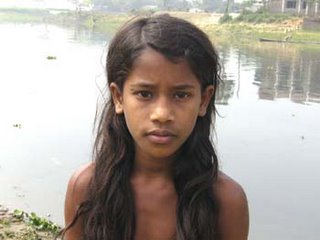
Khadeja and a friend:

Do all cows have funny ears?

Path connnecting villages:

Another river scene:

Three brothers:

We biked through the wide avenues of Bashundhara Housing and crossed a four-bamboo-wide bridge ("shako") to find ourselves in Khilkhet. Following a road, we crossed a river by boat, then followed the "path" and eventually looped back to the ferry. Although the terrain was mostly flat, scenery varied from wide open green fields to picturesque meandering rivers to tree-canopied paths connecting one village to another.
I was reminded once again why Bangladeshi villagers are quite possibly the friendliest people in the world. Several times kids offered to pluck ripe Kamrangas from the trees for us. At one household we had to dissuade women who wanted to go make Shemai for us. One girl, Khadeja, asked me if I had a daughter. When I said yes, she asked me to bring her to visit. Why, I asked. So I can see her and show her the village, said Khadeja. Don't forget my name, Khadeja of Bashabashi village, and I will be waiting to see your daughter.
In these villages cricket was the game of choice, followed by soccer. Few kids knew about the games of my childhood such as Kabadi or Dariabandha.
And of course everyone wanted to have their picture taken. Instant feedback of digital camera doubled the children's delight.
At the end of the journey we stopped at a tea stall in Khilkhet. We had tea/soft drinks and Christian bought some Samosas. Initially I worried about the bacteria, but then I relented and tried one. It was delicious and no, it did not make me sick.
All this within one hour of biking from Gulshan/Baridhara.
Many thanks to Nancy, Christian and Stefan for inviting me along on this trip.
Boats on the river Balu:

Field of green:

Bounty of tomatoes in a village:

A statue of Hindu goddess Kali at a village mandap:

More green:

Khadeja of village Bashabashi:

Khadeja and a friend:

Do all cows have funny ears?

Path connnecting villages:

Another river scene:

Three brothers:

Thursday, February 16, 2006
Getting Used to Hartals
Yesterday was a Hartal. It turned out to be quite relaxing. I came to work in a rickshaw, enjoying the early spring breezes on reasonably empty Dhaka streets and smelling the flowers (or the bus exhaust fumes on unfortunate moments.) Returned home in a CNG, but by that time the streets were getting crowded with post-hartal crowds.
My mood was in sharp contrast to hartals that I faced when I first got here last July. I was always on edge - should I take a Rickshaw or a CNG or a taxi? Should I just stay at home? Is some crazy mob going to attack me on the streets? - when a hartal was announced. Getting to work was a big struggle.
Of course, getting used to hartals does not mean they are good. Take for example the transport strikes that took place around SAARC time late 2005. Transport strikes are supposed to affect public transportation only - buses etc, and not private cars. A person who is close to me - a persistent and dynamic businessman - had a potential investor visiting from the USA. My friend had spent months setting up the visit, and the investor was really interested in building a factory. Well, my friend was taking his visitor in his private microbus to show the site of a proposed factory near Mymensingh. On the way some transport workers stopped their microbus and asked some questions, but eventually let them go on. My friend was able to show the place to the investor. But the investor was so unnerved by the incident on the road that he got on the next available flight, saying something like, "Your country is not ready for my investment". My friend smiled sadly when he told me this story.
So, hartals may be nice for me to enjoy Dhaka, but they are very very very bad for the country. The good thing is that most working people (excepting shopkeepers) go to work anyways on hartal days.
My mood was in sharp contrast to hartals that I faced when I first got here last July. I was always on edge - should I take a Rickshaw or a CNG or a taxi? Should I just stay at home? Is some crazy mob going to attack me on the streets? - when a hartal was announced. Getting to work was a big struggle.
Of course, getting used to hartals does not mean they are good. Take for example the transport strikes that took place around SAARC time late 2005. Transport strikes are supposed to affect public transportation only - buses etc, and not private cars. A person who is close to me - a persistent and dynamic businessman - had a potential investor visiting from the USA. My friend had spent months setting up the visit, and the investor was really interested in building a factory. Well, my friend was taking his visitor in his private microbus to show the site of a proposed factory near Mymensingh. On the way some transport workers stopped their microbus and asked some questions, but eventually let them go on. My friend was able to show the place to the investor. But the investor was so unnerved by the incident on the road that he got on the next available flight, saying something like, "Your country is not ready for my investment". My friend smiled sadly when he told me this story.
So, hartals may be nice for me to enjoy Dhaka, but they are very very very bad for the country. The good thing is that most working people (excepting shopkeepers) go to work anyways on hartal days.
Saturday, February 04, 2006
On the Grounds of Bhawal Raja
Last weekend, I had the opportunity to explore the Bhawal Raja's grounds in the company of my friend Tutul's Mama who lives in Joydebpur. We explored the RajBari and the Shoshan, the two largest structures remaining. But the highlight of the trip was a private house belonging to a relative of Tutul's, which used to be the temple of the Raja's younger sister. Unlike the other structures, this house is well-preserved.
Why the fascination with Bhawal Raja? I heard the story of Bhawal from my mother when I was a child and it captured my imagination. Bhawal was a large Zamindari (estate) close to Dhaka with its headquarters in Joydebpur. In 1909, the heir to this estate, Raja Ramendra Narayan Roy, died in Darjeeling. The story involves the appearance, in 1922, of a Sadhu in Dhaka. When this Sadhu visited Joydebpur, many people thought he looked like Raja Ramendra Narayan Roy. These people included the Raja's own sister who was delighted to have her long-dead brother back.
Eventually a legal battle ensued over whether this Sadhu was really the Raja of Bhawal. On one side were the British government (who had taken over the estate at this point in time because of the lack of heirs) and the wife of the Raja. The other side consisted of the Sadhu, the Raja's sister as well as numerous others from Bhawal. The British side insisted that the Raja had died in Darjeeling and was cremated there. The Sadhu's side claimed he had not died; that his body was not cremated, but had been left just before cremation because of a storm; and that a nearby group of Sadhus had rescued and revived the Raja who went on to become a Sadhu.
Popular versions of the story cast more evi aspersions on the Raja's wife. It was alleged that she was having an affair with the Raja's doctor and the two of them conspired to have the Raja killed.
In the end, after 20+ years of legal wrangling, the Sadhu won the case and the property. However, two days after the final victory, he died of a stroke.
The case is revisited in the book "Princely Impostor?", by Partha Chatterjee, which I read last year. The book is fascinating if a tad too long, and after thorough research in archives in Dhaka, London and Calcutta, the author concludes that he cannot decide if the man who appeared after 12 years was indeed the Raja or an impostor.
Back to Joydebpur. The first stop was the RajBari. This has become a government office suite now, housing the District Commisioner's offices as well as various courts. Some parts of the building were locked because it was Friday, which is weekly holiday. But we were able to enter otherr parts and look around. Sadly this was the same building outside of which a suicide bomber killed several people in 2005.
The next stop was the Shoshan. When I saw it I thought it was a temple, because of the spires. As each Raja in the dynasty died, a his ashed were kept in a spot and a spire built around it. There were several spires, and the picture of one Raja (Ranendra Narayan Roy) was inside one of the spires. Overall the Shoshan was in a bad state of repair.
The final stop was Tutul's relative who lives in the Mondir of the King's sister. The family got this property as part of property exchange after Partition in 1947. This property had some beautiful tile work, nice external work, as well as beautiful wooden doors.
Lastly there was the Dighi (pond), with a Ghat that is now destroyed. The Ghat was Rani Shwarna Kumari's. A marble plaque announcing her name was still part of the old delapidated Ghat. It had pock marks from 1971, when Pakistani soldiers apparently went at it with their bayonets.
Many thanks to Tutul, Mukul, Zia and of course Mama for this encounter with a childhood fascination.
Now the pictures: First the palace courtyard.

This is the wing where the Rani lived:

Workmanship on the top floor of the Rajbari:

Platform on 2nd floor from which Raja spoke to subjects (on the ground floor)
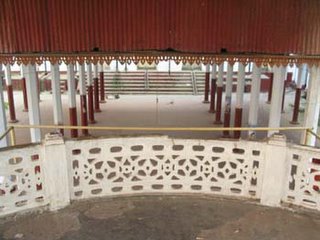
Window of a room in the RajBari:
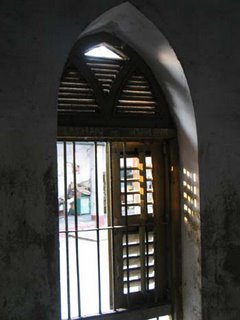
Spires of the Shoshan:

Picture of Raja Ranendra Narayan Roy inside the spire built around his ashes:

Tiles in the house that used to be Raja's sister's Mondir:

More tilework representing Krishna with Gopinis:
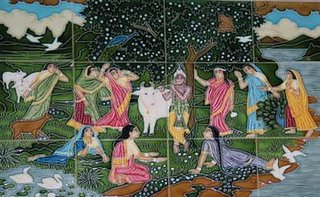
External work at the ex-Mondir:
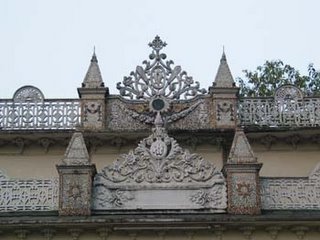
Plaque on the Pukur Ghat:

Why the fascination with Bhawal Raja? I heard the story of Bhawal from my mother when I was a child and it captured my imagination. Bhawal was a large Zamindari (estate) close to Dhaka with its headquarters in Joydebpur. In 1909, the heir to this estate, Raja Ramendra Narayan Roy, died in Darjeeling. The story involves the appearance, in 1922, of a Sadhu in Dhaka. When this Sadhu visited Joydebpur, many people thought he looked like Raja Ramendra Narayan Roy. These people included the Raja's own sister who was delighted to have her long-dead brother back.
Eventually a legal battle ensued over whether this Sadhu was really the Raja of Bhawal. On one side were the British government (who had taken over the estate at this point in time because of the lack of heirs) and the wife of the Raja. The other side consisted of the Sadhu, the Raja's sister as well as numerous others from Bhawal. The British side insisted that the Raja had died in Darjeeling and was cremated there. The Sadhu's side claimed he had not died; that his body was not cremated, but had been left just before cremation because of a storm; and that a nearby group of Sadhus had rescued and revived the Raja who went on to become a Sadhu.
Popular versions of the story cast more evi aspersions on the Raja's wife. It was alleged that she was having an affair with the Raja's doctor and the two of them conspired to have the Raja killed.
In the end, after 20+ years of legal wrangling, the Sadhu won the case and the property. However, two days after the final victory, he died of a stroke.
The case is revisited in the book "Princely Impostor?", by Partha Chatterjee, which I read last year. The book is fascinating if a tad too long, and after thorough research in archives in Dhaka, London and Calcutta, the author concludes that he cannot decide if the man who appeared after 12 years was indeed the Raja or an impostor.
Back to Joydebpur. The first stop was the RajBari. This has become a government office suite now, housing the District Commisioner's offices as well as various courts. Some parts of the building were locked because it was Friday, which is weekly holiday. But we were able to enter otherr parts and look around. Sadly this was the same building outside of which a suicide bomber killed several people in 2005.
The next stop was the Shoshan. When I saw it I thought it was a temple, because of the spires. As each Raja in the dynasty died, a his ashed were kept in a spot and a spire built around it. There were several spires, and the picture of one Raja (Ranendra Narayan Roy) was inside one of the spires. Overall the Shoshan was in a bad state of repair.
The final stop was Tutul's relative who lives in the Mondir of the King's sister. The family got this property as part of property exchange after Partition in 1947. This property had some beautiful tile work, nice external work, as well as beautiful wooden doors.
Lastly there was the Dighi (pond), with a Ghat that is now destroyed. The Ghat was Rani Shwarna Kumari's. A marble plaque announcing her name was still part of the old delapidated Ghat. It had pock marks from 1971, when Pakistani soldiers apparently went at it with their bayonets.
Many thanks to Tutul, Mukul, Zia and of course Mama for this encounter with a childhood fascination.
Now the pictures: First the palace courtyard.

This is the wing where the Rani lived:

Workmanship on the top floor of the Rajbari:

Platform on 2nd floor from which Raja spoke to subjects (on the ground floor)

Window of a room in the RajBari:

Spires of the Shoshan:

Picture of Raja Ranendra Narayan Roy inside the spire built around his ashes:

Tiles in the house that used to be Raja's sister's Mondir:

More tilework representing Krishna with Gopinis:

External work at the ex-Mondir:

Plaque on the Pukur Ghat:

Subscribe to:
Comments (Atom)